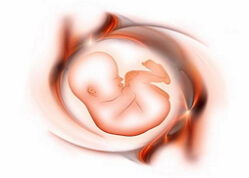Fetoplacental insufficiency
 Fetoplacental insufficiency in pregnancy is a pathological syndrome that includes a variety of structural and functional signs of placental dysfunction. Fetoplaccentral insufficiency is considered a potentially dangerous condition, as it provokes the most serious complications: violation of the proper development of the fetus( hypotrophy, hypoxia), untimely placental abruption, miscarriage, gestosis and others.
Fetoplacental insufficiency in pregnancy is a pathological syndrome that includes a variety of structural and functional signs of placental dysfunction. Fetoplaccentral insufficiency is considered a potentially dangerous condition, as it provokes the most serious complications: violation of the proper development of the fetus( hypotrophy, hypoxia), untimely placental abruption, miscarriage, gestosis and others.
The essence of the pathology is the change in normal blood flow in the area where the placenta is attached to the uterine wall( placental area).Since the fetus develops properly due to the vessels of the placenta, any blood flow disorder affects, above all, its condition.
The placenta as a temporary fully functioning organ is formed in a pregnant woman by the 16th week. It is to this term that the membranes and vessels of the placenta form the so-called "hematoplacental barrier" - an especial structure( membrane) that helps "communicate" fetal blood with maternal blood. The placenta functions just as much as the fetus is in the uterus, and is "born" after it.
To name the child's place in the placenta allowed a characteristic form of the organ, reminiscent of a thick cake( placenta in Latin is a "cake").The development of the placenta begins in the period of implantation - immersion of a fertilized egg( embryo) in the endometrium, more often - in the area of the uterine fundus. In its formation involved embryonic membranes - villous( chorion) and decidual. Chorion forms outgrowths( villi) and deeply immerses them in the mucous membrane. Between the villi is the space where the maternal blood flows. It should be noted that the blood of the fetus and the pregnant woman does not contact directly, because, thanks to the placental barrier, two autonomous blood flows are formed in the placenta zone - between the fetus and the intervillaceous space and between this space and the mother.
It is simply impossible to overestimate the importance of the placenta for the developing fetus, because it is through this structure that the most important functions for its life and development are realized:
- Nutrition. To the tissues and organs of the fetus to develop properly, according to the term of pregnancy, they need "building material" - vitamins, minerals and other important components, they are transported to the fetus by the placenta.
- Breathing. Carrying out gas exchange, like the lungs, the placenta "breathes" for the fruit: gives it oxygen and takes carbon dioxide.
- Selection. Any living organism, and hence the fruit, needs to "clean" the harmful products of life. The placenta participates in the processes of their elimination.
- Hormonal function. The placenta, among other important tasks, performs the tasks of the temporary hormonal gland. To prevent premature termination of pregnancy, the placenta maintains a constant concentration of progesterone, and the lactogen produced by it "prepares" the mammary glands for the future function of lactation.
- Protective. The fetus develops in a sterile environment, so it does not have its own immunity. To protect the developing organism from potential threats, the placenta delivers to the fetus the antibodies of the mother.
- Barrier. The placenta has the ability to "choose" the substances that enter the fetus, so it does not miss the "harmful" substances.
None of the functions of the placenta is realized autonomously. If the placenta, due to pathological reasons, does not cope with at least one of the listed problems, all the others also begin to be performed incorrectly, and a condition classified as fetoplacental insufficiency in pregnancy arises.
Placental dysfunction can exist for a long time and become chronic. Chronic fetoplacental insufficiency forces the fetus to adapt to not very favorable conditions, therefore there is a compensated form of pathology, which is successfully eliminated medically. If the degree of placental dysfunction increases, the compensatory capacities of both the placenta and fetus are depleted, and a stage of decompensation appears.
The most dangerous is acute fetoplacental insufficiency, when the placenta stops functioning correctly suddenly and is able to kill the fetus. Pathology can develop in the period of gestation, and directly in childbirth.
Fetoplacental insufficiency has a large number of causes, they are conventionally classified into internal, pathology-related mothers or the placenta itself, and external factors that affect pregnancy "from the outside."
What is fetoplacental insufficiency?
As already mentioned, at the heart of the pathology is a blood flow disorder in the zone where the blood vessels of the mother and fetus are reported. Trophic disorders inevitably provoke structural abnormalities in the placenta - its tissues are subject to irreversible changes and are already unable to function properly.
The degree of placental dysfunction is not always expressed in the same way, therefore the consequences for pathology are different. The longer the dysfunction lasts, the larger the area of the lesion, and hence the more pronounced the signs of fetoplacental insufficiency.
Since the placenta "is responsible" for all the developmental processes of the fetus and its interaction with the maternal organism, fetoplacental insufficiency is in the list of signs of the majority of pathologies of pregnancy - toxicoses, placental abruption( untimely), premature or late births and the like.
The conclusion about the presence of signs of placental dysfunction is often found and frightens pregnant women. To avoid unnecessary experiences, patients do not need to be able to understand the intricacies of ultrasound scans or diagnosis formulations. It is enough to know several important points:
- Insignificant signs of fetoplacental insufficiency can be diagnosed and with a physiologically occurring pregnancy against a background of temporary causes. As a rule, they are short-term, compensated independently, and the screening of placental dysfunction no longer detects.
- Much more important is not the statement of placental dysfunction itself, but the degree of its influence on the developing fetus. Therefore, any conclusion always contains information about the state of the child.
- The state of health of a pregnant woman is extremely rarely changed against the background of fetoplacental insufficiency, which hides the pathology of pathology. Often, pregnant women do not believe that they can feel good in the presence of fetal suffering, therefore understate the potential danger and refuse preventive hospitalization and therapy.
- Such conclusions as "risk of fetoplacental insufficiency" and "threat of fetoplacental insufficiency" are not diagnoses, but only indicate high risks of pathology development. However, the presence of risk does not imply the mandatory development of placental dysfunction, especially if preventive therapy is provided.
- Chronic fetoplacental insufficiency with appropriate drug support may result in the timely birth of a healthy child, but acute placenta dysfunction, especially long before the date of delivery, requires resuscitation.
Causes of fetoplacental insufficiency
Among the placental causes of placental dysfunction, there can be both internal( endogenous) and external( exogenous) factors. They are grouped into several groups:
1. External circumstances affecting the pregnant and placenta, respectively. Among them there may be those who had a negative effect on the body before fertilization.
The most common endogenous causes are:
- malnutrition, which does not allow to equip the pregnant woman and her child with the necessary substances;
- irrational food, meaning the use of "useful" products together with "harmful", or non-compliance with the food regime;
- stressful situations, when the rheology of the blood vessels of the placenta changes due to emotional vascular spasm caused by emotional overstrain, the pressure rises, and unwanted active damaging substances enter the bloodstream;
- an unfavorable environment( gas contamination, radiation background and the like);
- incorrect physical activity, except for the exercises recommended by the expert;
- associated with the profession of harmfulness, for example, staying close to aggressive chemical compounds, constant heavy physical labor and so on.
2. Complicated gestational period. First of all, we are talking about gestosis, a pathological symptom complex developing in the second gestation period. Each third of the pregnant woman on the background of gestosis, and recorded fetoplacental insufficiency.
Also affects the functioning of the placenta. The placenta has a limited "lifespan", so by the end of pregnancy its capabilities are depleted, in this case it is sometimes said that the placenta "grows old."If the pregnancy is prolonged longer than usual( more than 42 weeks), the placenta does not remain able to maintain the fetus properly.
When a single fetus develops in the uterine cavity with a single placenta, the threat of fetoplacental insufficiency becomes obvious, as usually the resources of the placenta are sufficient for a single child.
Often, dysfunction of the placenta is associated with its incorrect location in the uterus. Usually, the placenta is located in the area of the uterine bottom, and as you grow, it moves to one of its walls - the front or back. The uterine bottom is chosen by nature as a place of development of the embryo not by chance: it is well vascularized, does not contain muscle fibers with excessive contractile activity, and also ideally in anatomical terms. If the child's place is located in the lower uterine segment, there is a risk of fetoplacental insufficiency.
There is a correlation between the incidence of placental dysfunction and the age of the pregnant woman. As a rule, it is more often diagnosed in young( under 18 years) pregnant women, as well as overcoming the 35-year-old barrier.
3. The pathology of the reproductive system, as a rule, exists long before the present pregnancy. Often fetoplacental insufficiency is provoked by gynecological pathology: hormonal dysfunction, infectious processes, infertility. If the previous birth has already been complicated by the pathology of the placenta, the risk of a repetition of the negative scenario increases.
4. Chronic extragenital ailments. Almost half of the pregnant women with fetoplacental dysfunction have endocrine diseases, cardiac and / or vascular disorders, kidney, blood, and so on.
5. Congenital or hereditary diseases of the fetus or the most pregnant: developmental defects, chromosomal abnormalities.
6. Viral and bacterial infections, especially in the early stages of gestation, when the formation of the placenta is not over.
More often among the causes of fetoplacental insufficiency is several factors, not the only one.
Symptoms of fetoplacental insufficiency
Fetoplacental insufficiency in pregnancy is considered the most common complication of it. She is diagnosed with gestosis( 32%), with complicated extragenital pathology of pregnancy( 45%), with miscarriage( up to 77%).
The manifestations of placental dysfunction depend on the degree of its manifestation. Compensated chronic fetoplacental insufficiency often does not have specific subjective manifestations, therefore it is diagnosed only instrumentally. Any other form of placental dysfunction has clinical manifestations.
First of all, the fetus responds to abnormalities of the functioning of the placenta, as its vital functions directly depend on how correctly the placenta performs its tasks. The behavior of the fetus signals about hypoxia( oxygen starvation), first of all it manifests itself in a change in its motor activity. First, the pregnant woman herself notes that the movements of the fetus are more active and disorderly, and then the doctor listens to the palpitation( tachycardia) of the child.
It should be noted that the character of the motor activity of the fetus in the maternal womb is an informative indicator of its well-being. However, it is not always possible to determine whether the child "moves" correctly by herself, because the fetus reacts sensitively to a multitude of external and internal influences, even though it is absolutely healthy. As a rule, the doctor who watches pregnancy instructs the future mother to correctly assess the behavior of the fetus on the basis of special techniques.
At the first signs of oxygen deficiency in the fetus begins a drug correction. If treatment is not started, the degree of hypoxia is increasing. The wiggling becomes less frequent, and the fetal heart rate slows down( bradycardia).
Isolated symptoms of fetoplacental insufficiency appear only in the early stages, and then it is always accompanied by gestosis and the threat of premature termination of pregnancy.
It is possible to reliably determine the nature of the functioning of the placenta and the effect of existing disorders on the fetus only with instrumental and laboratory examination. Diagnostic search, in addition to examining anamnestic data and examination, will include:
- Laboratory diagnostics.
When microcirculation is disturbed in the placental area, the parameters of the clotting system, biochemical parameters change.
The hormonal function of the placenta with its dysfunction is also distorted, therefore, in the diagnosis of fetoplacental insufficiency hormonal studies are present.
- Instrumental research.
Ultrasound scanning allows to determine the nature of structural disorders in the placenta. Its thickness is measured, pathological inclusions are detected, and the degree of maturity is determined. Ultrasound maturity criteria for the placenta are as follows:
- zero degree( before the 30th week): the placenta is uniform, the chorionic( adjacent to the fetus) surface is even;
- first degree( 27-36 weeks): the placenta still looks uniform, but contains a small number of seals, visualizes the undulating chorionic part and microscopic calcium deposits;
- the second degree( 34-39 weeks): the chorionic surface looks more sinuous because of the depressions, the placental structure becomes denser, the calcifications are clearly visible;
- the third degree( after the 36th week): deepening of the chorionic part reaches the basal membrane, therefore the placenta looks divided into fractures, cysts and numerous calcifications are visualized in its structure.
Data on the degree of maturity of the placenta can not serve as a basis for assessing the condition of the fetus. To determine how the placenta changes affects the baby, Doppler is needed - a technique for studying the features of the blood flow in the placental area.
It should be noted that, according to the results of the examination, the condition of the placenta and fetus is not always correlated: prematurely the "aging" placenta may not affect the baby's health, nor does the placenta of "normal" maturity sometimes copes with its tasks.
Ultrasound scanning also assesses the extent to which fetal development corresponds to the gestational age, that is, determines if there is a delay in its development.
Another method that allows you to study the health of the fetus is cardiotocography( CTG).It records the heartbeat and movements of the fetus over a certain time period.
The conclusion about the "aging" of the placenta is often unfoundedly frightening the pregnant woman. Meanwhile, patients do not need to delve into all the subtleties of expert opinions to adequately relate to what is happening. It is enough to know the most important thing:
- The placenta does not have an independent meaning and does not carry any threat, especially if Doppler and CTG did not detect a threat.
- In determining the maturity of the placenta, diagnostic errors associated with measurement errors are not uncommon.
- If the blood flow in the placenta is not changed, and the fetal heart rate is normal, you can safely not remember the "aging" of the child's place.
- "Cure" a prematurely ripened placenta is impossible. If it does not prevent the fetus from developing properly, therapy is not required.
- Fetal hypoxia due to placental dysfunction does not always require serious therapy. It is used only if there is a pronounced oxygen deficit.
- "Aging" of the placenta does not require an early delivery. It is performed only in the case of acute fetoplacental insufficiency, when the fetus may die. In the chronic form of placental dysfunction, caesarean section is rare, its basis is the severe degree of fetal hypoxia.
Degrees of fetoplacental insufficiency
Fetoplacental insufficiency is classified according to several symptoms:
1. Depending on the moment of appearance of signs of placental dysfunction.
Primary fetoplacental insufficiency is considered in situations when it appears in early( up to 16 weeks) terms and is associated with impaired embryo implantation or placenta formation.
Secondary fetoplacental insufficiency appears much later, when the placenta is already functioning with the existing disorders. Its causes can be any external negative factors that can provoke dysfunction.
2. By the type of course of pathology.
Acute fetoplacental insufficiency occurs against the background of clinical well-being after a negative event, such as a sudden placental abruption, when its site separates from the uterine wall and ceases to function. More often it occurs directly in sorts or shortly before their approach, but can happen and at any other time.
Chronic fetoplacental insufficiency is diagnosed at any gestation period. It is characterized by a long current and is subdivided, in turn, into:
- compensated form, when against the background of metabolic disturbances in the placenta changes in blood flow parameters are not recorded;
is a decompensated form, characterized by deeper disorders, including vascular disorders.
With a decompensated form of pathology, the placenta is unable to maintain the vital functions of the fetus at the proper level.
Decompensated fetoplacental insufficiency has several degrees. Each degree reflects the level of circulatory disorders in two important systems - the mother / placenta and the placenta / fetus.
Degree 1a - the blood flow is disturbed only in the uterus / placenta system.
Degree 1b - incorrect circulation in the area between the fetus and the child's place.
Degree 2 - total change in blood flow in both circles( "mother / placenta" and "fetus / placenta"), but it is not critical.
Degree 3 - differs from the previous one by the presence of a real threat to the life of the fetus due to a critical violation of the blood circulation between the fetus and the placenta.
The degrees of fetoplacental insufficiency should not be confused with the degree of maturity of the placenta, since these concepts are not identical.
What is the "maturity" of the placenta? As already mentioned, the placenta grows with the fetus in order to meet its growing needs. It is customary to say that the placenta "ripens" or "grows old," because as the fetus grows, its functional reserve is depleted. In case of physiological pregnancy, the placenta becomes old after fully ensuring the proper development of the fetus, that is, on the eve of childbirth. A number of diagnostic parameters have been developed, according to which it is possible to determine the "age" of the placenta and compare it with the gestation period.
There are three degrees of maturity of the placenta( in fact, they are also its stages of development):
- Zero degree - is diagnosed before the 30-week period;
- Degree I - refers to the 27th - 36th week;
- Degree II - appears on the 34th - 39th week;
- Degree III - is registered after the 36th week.
The degree of aging of the placenta is determined during ultrasound scanning. Its thickness, presence or absence of cysts and calcium deposits are determined.
It should be noted that prematurely aged placenta( degree III before the 35th week) does not provoke fetal death or miscarriage, but only requires increased attention and medication support. Threatening is not considered to be the aging of the placenta, but its combination with a pronounced fetoplacental insufficiency and, accordingly, fetal suffering.
There is one more classification of fetoplacental insufficiency, which takes into account its effect on the fetus, as in 60% of patients with this pathology of pregnancy the fetus has signs of developmental delay. Allocate:
- fetoplacental insufficiency without signs of delayed fetal development;
- fetoplacental insufficiency with symptoms of fetal maldevelopment.
Treatment of fetoplacental insufficiency
It is impossible to cure fetoplacental insufficiency, as it is impossible to replenish placenta reserves artificially. The meaning of all the measures carried out is medical compensation, so that the pregnancy is prolonged, and the fetus develops properly.
There are no specific, suitable for all pregnant, therapy schemes. For each case, selected their own medication, the timing of therapy, as well as the question of the place of its conduct( hospital or women's consultation).
The list of treatment measures depends on the specific situation, the degree of placental dysfunction, and the data on the fetal condition.
First and foremost, therapy should compensate for circulatory disorders in the placenta. Used drugs that improve trophic tissue, restoring vascular tone and rheology.
Often fetoplacental insufficiency provokes an increase in the tone of the uterine musculature, which can trigger the onset of too early births. As part of complex therapy, there are funds that remove the uterine tone, improve metabolic processes in the uterine wall, soothing drugs.
Expressed placental dysfunction inevitably provokes a hormonal imbalance, so the placenta can no longer maintain pregnancy without external support. If laboratory diagnostics reveals hormonal deficiency, progesterone preparations are prescribed.
It is impossible to affect the structural abnormalities in the placenta tissues, however, it is possible to eliminate the causes that aggravate placental dysfunction, more often maternal pathologies( diabetes, hypertension, vascular and cardiac pathologies, dyshormonal disorders, and the like) are those.
As before, uncomplicated rules regarding the dietary intake, proper physical activity, psychological comfort, which are necessary for a healthy pregnant woman, and for having any pathology remain relevant.
The effectiveness of the complex treatment is evaluated by specialists in functional diagnostics.
Contrary to popular belief among patients, fetoplacental insufficiency does not always serve as a basis for premature( before 37 weeks) delivery. It is performed in the case of ineffective therapy and / or threatening fetal conditions, as well as in the case of acute placental dysfunction.
Prevention of fetoplacental insufficiency
In most situations, the appearance of fetoplacental insufficiency is predictable, so preventive measures are very relevant.
Ideal in this regard is the situation where a woman who wants to become pregnant beforehand undergoes examination and treatment of existing pathologies. However, in time to assess the risk of development of pathology is possible during pregnancy, especially in the early stages.
The possibility of preventing placental dysfunction and its effectiveness directly depend on the cause of the pathology. If the causes of pathology are hidden in the embryo implantation period, when the placenta is initially formed incorrectly, it is difficult to prevent its appearance.
The preventive program includes:
- Non-drug methods: diet, vitamin intake, adequate rest and adequate physical activity.
- Medical measures: improvement of tissue metabolism, normalization of the functioning of the central nervous system, rheology-improving drugs, sedative therapy.



